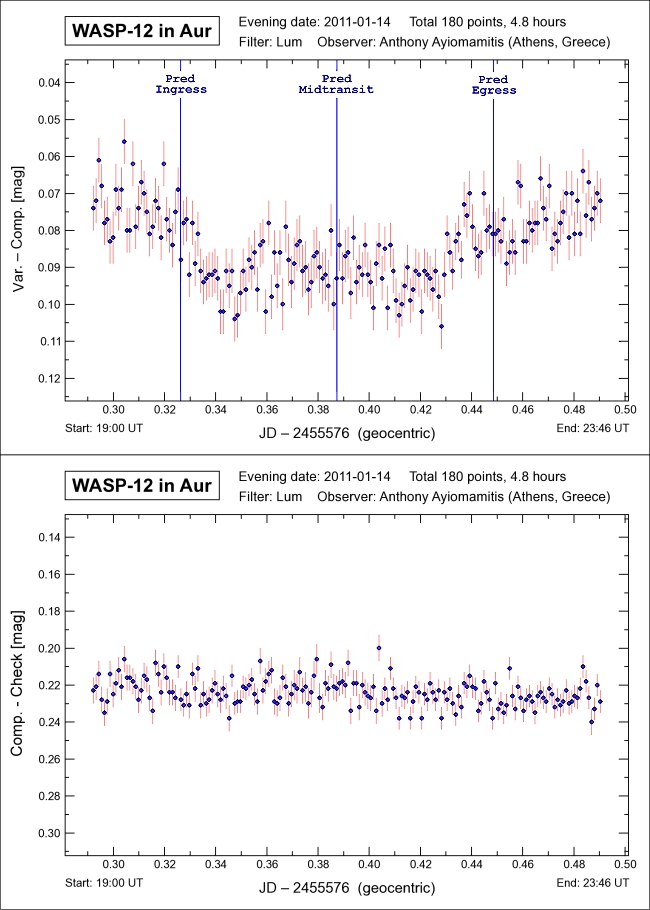
A variable star, as its name suggests, is a star whose magnitude varies intrinsically, in contrast to eclipsing
binaries whose magnitude varies as a result of one star in the binary system eclipsing the other. True variables are
one of five types, namely Mira stars, semiregular stars, cepheids, eruptive variables and, finally, cataclysmic
variables. Minimum to maximum magnitude can range from days to many months with some variables displaying irregular
periods.
A popular method for the study of variable stars, particularly short-term variables, is by the use of the technique
known as "differential photometry". Rather than measure the (variable) magnitude of a variable star on an absolute
scale, measurements are made over time relative to one or more non-variable star(s) and these differences are then
plotted so as to study and illustrate the relative or differential change in magnitude. Due to the very large number
of variables stars, the field of differential photometry represents one of the key fields in astronomy whereby the
amateur astronomer can make a meaningful and long-lasting contribution to both science and astronomy.
More recently, the search for extrasolar planets (511 discovered so far) has identified yet another interesting
application for the practice of differential photometry whereby the minute drops in magnitude of a star hosting an
exoplanet are studied. Further details for the interested party are available
here.
Note: The light curve for exoplanet WASP-12b in Auriga depicted below is one of the latest
(and largest) transitting exoplanets, having being announced in Dec/2008, and represents the twelventh discovery
by the WASP (Wide Angle Search for Planets) team. WASP-12b is characterized with a mass 1.41 times that of Jupiter
while its radius is equivalent to 1.79 Jupiter radii, thus making this exoplanet the largest discovery at the time.
What really sets WASP-12b apart is the fact that models suggest a surface temperature of 2516° Kelvin and which makes
it the hottest exoplanet discovery so far owing to a very brief orbital period of 1.09 days (the shortest orbital
period yet detected). WASP-12b requires 175.7 minutes to transit its parent star at a depth of
15.0 mmag or 1.50%. The parent star, 2MASS J063032.79+294020.4, is an F9V star estimated to have a mass of 1.35 solar
masses, a radius equivalent to 1.57 solar radii, a temperature of 6,300° K and to lie at a distance of 871 light-years
away with a visual magnitude of 11.69. Further details regarding WASP-12 and WASP-12b are available in the paper
published by the discovery team led by Hebb et al here.
Note: Due to the proximity of WASP-12b to its host star, namely 2% that of earth's distance
from the Sun, the life expectancy of WASP-12b is approximately 10 million years owing to the fact WASP-12 continually
strips away WASP-12b's atmosphere and the host star will eventually devour the exoplanet.
Note: The C- and K-stars used for the purposes of the differential photometry measurements
depicted below were GSC 1891:324 (mag 11.3) and GSC 1891:876 (mag 11.7) respectively.
|
Parent Star: 2MASS J063032.79+294020.4 GSC/SAO Catalog: N/A Constellation: Auriga RA / Dec: 06h 30m 32.79s / +29° 40' 20.4" Magnitude: 11.69 Distance: 871 light-years Exoplanet: WASP-12b Period: 1.091423 + 0.000003 d Transit Duration: 175.7 mins Transit Depth: 15.0 mmag Minimum Mass: 1.41 MJup Radius: 1.79 RJup Pred Transit Details:
|
 |
Date: Jan 14-15, 2011 21:00:00 - 01:46:50 UT+2 Location: Athens, Greece Equipment: AP 160 f/7.5 Starfire EDF AP 1200GTO GEM SBIG ST-10XME SBIG CFW-10 SBIG Lum filter Integrations:
Temperatures:
Software: CCDSoft V5.00.201 AIP4Win V2.2 Processing: Reduction Differential Photometry |